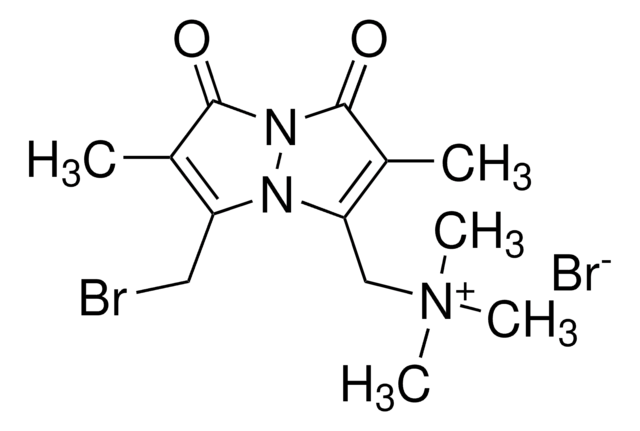추천 제품
제품 라인
BioReagent
Quality Level
분석
≥95% (HPCE)
양식
solid
mp
152-154 °C (lit.)
solubility
DMF: soluble
DMSO: soluble
acetonitrile: soluble
methanol: soluble
형광
λex 390 nm; λem 478 nm in 0.1 M phosphate pH 7.5 (after derivatization with glutathione)
λex 398 nm
적합성
suitable for fluorescence
저장 온도
2-8°C
SMILES string
CC1=C(C)C(=O)N2N1C(CBr)=C(C)C2=O
InChI
1S/C10H11BrN2O2/c1-5-7(3)12-8(4-11)6(2)10(15)13(12)9(5)14/h4H2,1-3H3
InChI key
AHEWZZJEDQVLOP-UHFFFAOYSA-N
유사한 제품을 찾으십니까? 방문 제품 비교 안내
일반 설명
Bromobimane, also called probe for thiols, is a fluorescent reagent activated upon a photolysis reaction. Bromobimane in solution reacts with small thiol groups (e.g., GSH) and with reactive protein thiol groups (e.g., hemoglobin). The reaction of Bromobimane with thiols is of second-order and dependent on pH. And, upon reacting with thiolate, it activates the water-soluble fluorescent product for detection.
애플리케이션
Bromobimane is used for the determination of thiols by the HPLC method. It is suitable as a pre-column derivatization agent for fluorometric determination of 2,3-dimercaptopropane-1-sulfonic acid and other dithiols. Bromobimane has been used as a fluorescent label in studying oligomycin-sensitive ATPase from beef heart mitochondria.
특징 및 장점
The benefits of using Bromobimane for the analysis of low molecular weight thiols are: Highly selective.
- Rapid reactivity.
- Ease of separation of derivatives by reverse HPLC.
- Ability to penetrate cells.
포장
Bottomless glass bottle. Contents are inside inserted fused cone.
기타 정보
Fluorescent thiol-specific reagent
Storage Class Code
11 - Combustible Solids
WGK
WGK 3
Flash Point (°F)
Not applicable
Flash Point (°C)
Not applicable
개인 보호 장비
Eyeshields, Gloves, type N95 (US)
이미 열람한 고객
R M Maiorino et al.
Journal of chromatography, 374(2), 297-310 (1986-01-24)
The increasing therapeutic use of dithiol metal binding agents, such as 2,3-dimercaptopropane-1-sulfonic acid (DMPS), has stimulated the need for a sensitive and selective method for their determination in biological fluids. A method has now been developed in which DMPS was
P C Chinn et al.
Analytical biochemistry, 159(1), 143-149 (1986-11-15)
A highly sensitive and specific assay for Escherichia coli thioredoxin was developed using the thiol-specific reagent monobromobimane. Treatment of dithiothreitol-reduced thioredoxin with an excess of monobromobimane in Tris buffer (pH 8.0, 23 degrees C) for 30 min resulted in the
Carl Simonsson et al.
The Journal of investigative dermatology, 131(7), 1486-1493 (2011-01-14)
Allergic contact dermatitis (ACD) is the most prevalent form of human immunotoxicity. It is caused by skin exposure to haptens, i.e., protein-reactive, low-molecular-weight chemical compounds, which form hapten-protein complexes (HPCs) in the skin, triggering the immune system. These immunogenic HPCs
Michael Hall et al.
Proteomics, 10(5), 987-1001 (2010-01-06)
The light-dependent regulation of stromal enzymes by thioredoxin (Trx)-catalysed disulphide/dithiol exchange is known as a classical mechanism for control of chloroplast metabolism. Recent proteome studies show that Trx targets are present not only in the stroma but in all chloroplast
Joachim Volk et al.
Dental materials : official publication of the Academy of Dental Materials, 25(12), 1556-1563 (2009-09-01)
Camphorquinone (CQ) is cytotoxic in cell cultures. The mechanism of this toxic action, however, is not yet clearly understood. Aim of this investigation was to analyze the effects of non-irradiated CQ on intracellular formation of reactive oxygen species (ROS), intracellular
자사의 과학자팀은 생명 과학, 재료 과학, 화학 합성, 크로마토그래피, 분석 및 기타 많은 영역을 포함한 모든 과학 분야에 경험이 있습니다..
고객지원팀으로 연락바랍니다.









